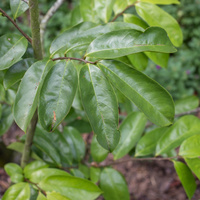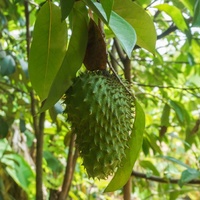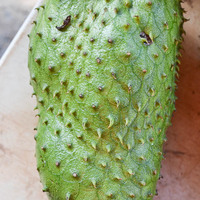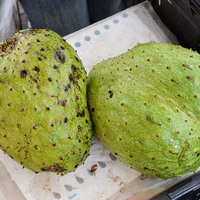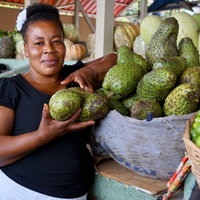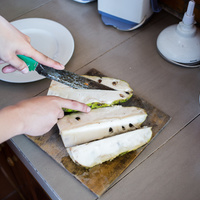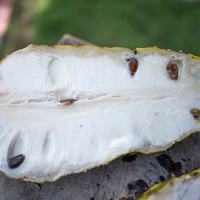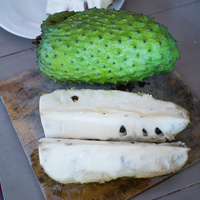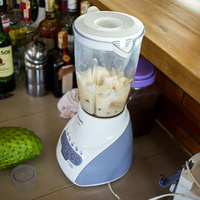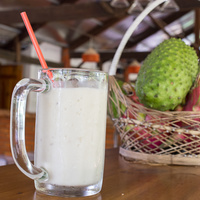Common name: Soursop
Other common names: Brazilian paw paw, Graviola, Prickly custard apple, Soursapi
Description
Soursop is a custard apple relative bearing large fruit, probably the largest in the custard apple family.
Originating in humid regions of tropical America, soursop is now introduced and cultivated in Africa, India, Southeast Asia, Australia, Hawaii and the wider Pacific.
It is a small, densely leafy tree 3 to 8 m (10 to 26 ft) tall with a slender trunk and low-branching habit, forming a pyramidal or narrowly rounded crown. The bark is grey to grey-brown and smooth.
Leaves are oblong, from 10 to 20 cm (4 to 8 in) long, dark glossy green on top, pale dull green underneath, alternately arranged along the branches and remain on the tree throughout the year. However, some leaf-fall may occur in areas with a long or pronounced dry season.
Flowers are 3 to 5 cm (1.2 to 2 in) long and have a three-sided pyramidal shape, consisting of three outer and three inner yellow petals slightly opening. They are bisexual, with both female and male parts and are borne singly on the trunk and branches during the humid months. Hanging pendant on short stalks, they give off a sweet, musky odour attracting pollinating insects.
The fruit that follow are oval to heart-shaped and large, typically 15 to 40 cm (6 to 16 in) long, up to 20 cm (8 in) wide, weigh from 1 to 7 kg (2.2 to 15 lbs) and have thin green skin dotted with soft spikes. Immature fruit are dark green and firm, becoming pale green and with a musky odour when mature, indicating its readiness for harvesting.
After harvesting, the fruit are stored for around four to five days, becoming soft to the touch when fully ripe. The thin skin is easily peeled, revealing soft, juicy, fibrous white pulp studded with large, oblong, glossy dark brown seed.
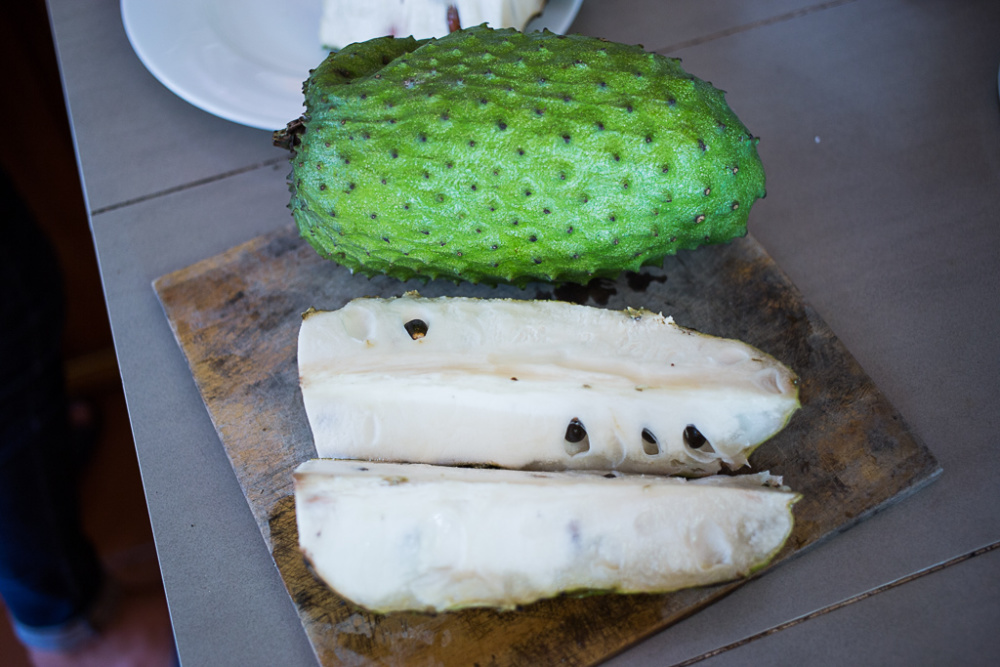
Use
The pulp can be eaten fresh out of hand, though it is more commonly pressed through a sieve to extract the juice or liquefied in a blender. Before processing, care is taken to remove and discard all of the large seed. In its natural form, the juice or liquefied pulp is milky-white, thick, creamy and smooth, with a unique sweet-sourish flavour and slightly musky aroma.
Soursop pulp is made into chilled drinks and desserts, including smoothies, ice cream and sorbets. In the West Indies, the juice is extended by smoothing it with milk and then is spiced with grated nutmeg (Myristica fragrans) to make a refreshing drink. The de-seeded pulp can also be torn or cut into pieces and mixed in a fruit salad, or it can be chilled or frozen for later use.
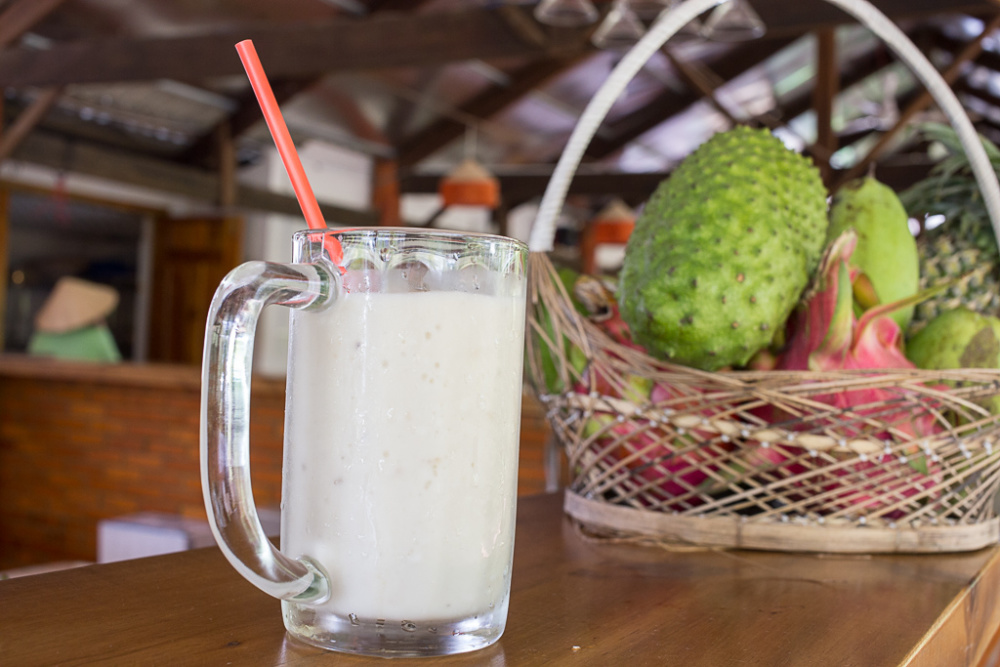
Soursop smoothie (Vietnam)
Climate
Soursop grows naturally and produces a fair-to-good crop of fruit in sub-humid to humid subtropical and tropical climates, generally frost-free areas with annual lows of 13 to 25°C, annual highs of 24 to 35°C, annual rainfall of 800 to 4000 mm and a dry season of 7 months or less, extending to drier areas with irrigation or groundwater.
Soursop trees fail to thrive in areas where the average low of the coldest month is below 8°C (45°F) and may die back if exposed to frost. Further, the tree needs both warmth and humidity to initiate flowering, which may not occur in areas where the springtime climate is too cool or dry.
Growing
New plants usually start from seed but can also be produced using air-layering (circumposing) methods. Young plants can be planted out when around 30 cm (12 in) tall and at the start of the rainy season. They develop quickly under good growing conditions and may start to flower and fruit in their third or fourth year.
Growth and fruiting performance are best on rich, free-draining loam and sand soils of a moderately acid to slightly alkaline nature, generally in the 5.5 to 7.5 pH range, and on sites with full to partial sun exposure.
Although moderately drought tolerant, soursop trees have a shallow root system and benefit from irrigation and mulching in low rainfall areas, particularly when flowering and fruiting. Trees perform poorly on clayey, slow-draining and waterlogged soils, with poor fruit-set and low yields the usual result.
Varieties include ‘Bennett’ (large fruit with flavoursome pulp), 'Whitman fibreless' (delicious melting pulp, but a shy bearer), 'Giant' (produces exceptionally large fruit), ‘Morada’ (commercial variety from Colombia), and 'Ratu’ and ‘Sirsak' (from Southeast Asia). There is also 'Mountain', a cold-tolerant, highland variety with pale yellow pulp. However, the flavour is poor, and it is instead mainly used as rootstock for other varieties.
Yields of up to fifty fruit per tree per year have been reported for ten-year-old trees grown under intensive cultivation. However, yields vary significantly among the different varieties and under different growing conditions, with yields from homegrown trees about half to a quarter that of trees in commercial orchards.
Problem features
Soursop has been recorded as having escaped cultivation and as a weed of the natural environment and agriculture. However, there does not appear to be any records of it anywhere as a serious weed or invasive species. It is assessed as a low weed risk species for Hawaii by the Hawaii Pacific Weed Risk Assessment (HPWRA) project.
The seed are reportedly toxic and have been used traditionally as an insecticide and fish poison.
Where it grows
References
Books
-
Adams, C. D. 1972, Flowering plants of Jamaica, University of the West Indies, Mona, Greater Kingston
-
Allen, B. M. 1967, Malayan fruits : an introduction to the cultivated species, Donald Moore Press, Singapore
-
Food and Agriculture Organization of the United Nations (FAO) 1986, Food and Fruit-bearing Forest Species, 3 : Examples from Latin America, FAO Forestry Paper no 44/3, Rome
-
Jacquat, C. & Bertossa, G. 1990, Plants from the markets of Thailand : descriptions and uses of 241 wild and cultivated plants, with 341 colour photographs, Editions Duang Kamol, Bangkok
-
Janick, J., & Paull, R. E. 2008, The encyclopedia of fruit & nuts, CABI Publishing, Wallingford, Oxfordshire
-
Jensen, M. 1999, Trees commonly cultivated in Southeast Asia : an illustrated field guide, 2nd ed., Food and Agricultural Organisation of the United Nations (FAO) Regional Office for Asia and the Pacific (RAP), Bangkok
-
Little, E. L. et al. 1964 and 1974, Common trees of Puerto Rico and the Virgin Islands (2 volumes), Forest Service, U.S. Department of Agriculture (USDA), Washington D.C.
-
Lorenzi, H. 2006, Brazilian fruits & cultivated exotics (for consuming in natura), Instituto Plantarum de Estudos da Flora, Nova Odessa, San Paulo
-
Macmillan, H. F. 1943, Tropical planting and gardening : with special reference to Ceylon, 5th ed, Macmillan Publishing, London
-
Martin, F. M., et al. 1987, Perennial edible fruits of the tropics : an inventory, U.S. Dept. of Agriculture (USDA), Agricultural Research Service, U.S. Government Printing Office (GPO), Washington, D.C.
-
Morton, J. F. & Dowling, C. F. 1987, Fruits of warm climates, Creative Resources Systems, Winterville, North Carolina
-
National Research Council (Board on Science and Technology for International Development) 1975, Underexploited tropical plants with promising economic value, National Academic Press, Washington D. C.
-
Norrington, L. & Campbell, C. 2001, Tropical food gardens : a guide to growing fruit, herbs and vegetables in tropical and sub-tropical climates, Bloomings Books, Hawthorn, Victoria
-
Perkins, K. D. & Payne, W. 1981, Guide to the poisonous and irritant plants of Florida, Florida Cooperative Extension Service, Gainesville, Florida
-
Perry, F. & Hay, R. 1982, A field guide to tropical and subtropical plants, Van Nostrand Reinhold Company, New York
-
Prasanna, P.V. 2012, Trees of Hyderabad: A Pictorial Guide, 1st ed., Botanical Survey of India (BSI), Indian Government Ministry of Environment and Forests, Kolkata
-
Queensland Department of Primary Industries and Fisheries (QLD DPI) 2008, Queensland tropical fruit : the healthy flavours of North Queensland, Brisbane
-
Randall, R. P. 2002, A global compendium of weeds, R.G. and F.J. Richardson Press, Melbourne
-
Randall, R. P. 2007, The introduced flora of Australia and its weed status, Cooperative Research Centre for Australian Weed Management, Glen Osmond, South Australia
-
Selvam, V. 2007, Trees and shrubs of the Maldives, Food and Agriculture Organisation (FAO) RAP publication (Maldives), Thammada Press Company Ltd., Bangkok
Articles, Journals, Reports and Working Papers
-
Percival, S. & Findley, B. 2007 (Reviewed April 2014), What's in Your Tropical Fruit?, Fact Sheet HN 0708, University of Florida IFAS Extension Service, Gainesville, Florida
-
Subhadrabandhu, S. 2001, Under-utilized tropical fruits of Thailand, Food and Agriculture Organisation of the United Nations (FAO), Regional Office for Asia and the Pacific (RAPA), Bangkok
-
Watson, B.J., & Moncur, M. 1985, Guideline criteria for determining survival, commercial and best mean minimum July temperatures for various tropical fruit in Australia (Southern Hemisphere), Department of Primary Industries Queensland (DPI QLD), Wet Tropics Regional Publication, Queensland
